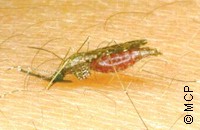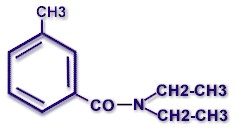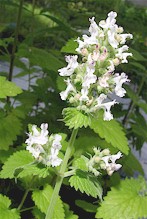What are Repellents?
Repellents are natural or synthetic chemicals or products that keep parasites or whatever undesirable "bugs" away from humans and domestic animals to which they are naturally attracted, mostly for feeding or egg laying.
To be repellent, a chemical compound must reach the approaching parasite before it lands or otherwise gets in contact with its host. To achieve this the compound must necessarily be volatile, i.e. applied on the host (directly or in devices such as collars or ear-tags impregnated with it) it must evaporate enough to build a cloud around it that once perceived by the parasite, it will discourage it from making contact with the host.
 The need to be volatile inevitably implies that sooner or later it will completely evaporate from the hosts' body (or the carrier device) that will remain unprotected. The bottom line is that repellents always have a short residual effect and protection won't last long. In fact, most repellents provide only a few hours protection, seldom more than one day, just because they evaporate completely. Only if a repellent is included in a slow-release device (collars, ear-tags) protection will last longer.
The need to be volatile inevitably implies that sooner or later it will completely evaporate from the hosts' body (or the carrier device) that will remain unprotected. The bottom line is that repellents always have a short residual effect and protection won't last long. In fact, most repellents provide only a few hours protection, seldom more than one day, just because they evaporate completely. Only if a repellent is included in a slow-release device (collars, ear-tags) protection will last longer.
A protection period of a few hours may be usually enough for a walk with the dog, or for a horse ride. But it is always insufficient for livestock.
Most research on repellents has been carried out basically to protect humans, especially against mosquitoes, due to their well-known capacity to transmit numerous human diseases (e.g. malaria and yellow fever). The armies in many countries were and remain especially interested in such repellents to protect soldiers from diseases transmitted by mosquitoes and other parasites.
Research on repellents for pets, horses or livestock against their major parasites (fleas, flies, ticks, etc.) is rather scarce and so far not really very successful. If ever available, repellents for pets, horses and livestock are frequently spin-offs of human products.
There are numerous parasites that are not suitable to be repelled, simply because they do not actively search a pray but are transmitted passively through close contact between hosts. This is e.g. the case of lice, mites and parasitic worms.
Use of repellents on livestock, horses and pets
The use of repellents on livestock is mostly useless and/or too expensive. Very few important livestock parasites can be effectively repelled; perhaps mosquitoes and a few fly species. And if ever, only for a few hours, because repellents evaporate quickly, especially outdoors exposed to sunlight and high temperatures. In addition, repellents do not reduce the parasite populations as parasiticides do. This is also the reason why there are almost no commercial repellents for livestock.
For dogs, cats and horses there are numerous commercial brands that claim to repell various parasites such as flies, fleas, mosquitoes, etc. Most of them belong to the category of shampoos, soaps, sprays and the like, and often contain natural products such as pyrethrins, linalool, D-limonene, geraniol, citronelol, thymol, etc. A single treatment with such products may provide sufficient protection of pets or horses for a few hours, but not for days or weeks . They may be adequate for a short walk outdoors, but are normally useless under constant exposure to high parasite populations as can happen in many rural areas, or to herd dogs and working horses.
There are no repellents against parasitic worms (helminths) of livestock and pets, since most of them infect their hosts through the food or drinking water. For the few ones that are transmitted by insect vectors effective repellents could theoretically reduce the infection risk. The problem is that such repellents are usually not effective enough, and a single bite of a parasite can already transmit the disease.
Synthetic repellents

DEET (N,N-Diethyl-meta-toluamide). DEET is the oldest and most used synthetic repellent, especially to protect humans against mosquitoes, either applied directly on the skin, or on clothing. The US army developed it after the jungle experience during World War II. The US army introduced it in 1946 and used it e.g. during the Vietnam War. In 1957 it was introduced for civil use.
One of the known mechanisms of action of DEET on mosquitoes is the blocking of olfactory receptors of the insect that perceive attractants in human breath and sweat. As a consequence the insect does not recognize the potential host as an attractive pray. Another mechanism seems to affect the olfactory receptors in the insects' antennae that perceive the odour as unpleasant and consequently avoids the treated pray.
For use on humans DEET is mostly used in the form of sprays, lotions, creams, etc. The length of the repellent effect depends on the concentration of DEET. For a product with 100% concentration (i.e. pure DEET) up to 12 hours effect against mosquitoes has been reported. Some tick species may be repelled for 2 to 4 hours. However, for safety reasons not all countries allow products with a 100% concentration: e.g. the maximum allowed concentration in Switzerland is 30%. DEET is also a good organic solvent that can damage plastics (including synthetic tissues such as nylon), leather, varnishes, nail lack, etc.
There are only few commercial products with DEET for horses and pets. Use on livestock is irrelevant, for obvious economic and practical reasons.
ICARIDIN is an insect repellent discovered and marketed by BAYER that is that is used in humans under various trade names (e.g. AUTAN, BAYREPEL, SALTIDIN). It is also called picaridin or hepidanin. It seems to be as effective as DEET without the inconvenience of being an organic solvent. It was introduced in Europe in 2001. The duration of the repellent effect is not longer than for DEET, i.e. a few hours. So far there are no commercial products with icaridin for livestock or pets.
Synthetic PYRETHROIDS, an important chemical class of insecticides, also show a certain repellent effect on various veterinary parasites, especially flies and mosquitoes. Such effect is usually not strong enough to keep the parasites away from the treated host, and many of them actually land on it and are than killed by the insecticidal effect (if they have not yet develop resistance...). The repellent effect of sybthetic pyrethroids depends on numerous factors such as the specific compound, the parasite species, the application method, the dose applied, etc. As a general rule, synthetic pyrethroids are basically parasite killers, and their repellent effect is usually not very relevant for practical purposes.
AMITRAZ (and other amidines) is a widely used tickicide that has also a repellent effect against ticks, but not against flies, mosquitoes or other insects. Many ticks will not attach to hosts that have been treated with amitraz, or only in very low numbers. If amitraz is applied to an already infested animal, many ticks that were attached and sucking blood will quickly detach and fall off the animal without completing engorgement.
There are other synthetic molecules for which a certain insect or tick repellent effect has been described, but none has been so far introduced for use on humans or animals.
Natural repellents
Natural PYRETHRINS are a mixture of pyrethrin I and II extracted from various plants (e.g. Chrysanthemum cinerariaefolium). Pyrethrins are broad-spectrum contact insecticides with a fast knockdown, but with only short residual effect because the UV rays in sunlight break them down quickly. But at low concentrations they have a repellent effect against several insects.

NEPETALACTONE is an organic compound extracted from Nepeta cataria (catnip, catmint, catswort), which is known to attract cats and is also a repellent of mosquitoes, cockroaches and termites. Apparently it is as strong a repellent as DEET, but is not as effective when used directly on the skin. It is not used on livestock or pets.
MENTHOGLYCOL (also known as p-Menthane-3,8-diol, para-menthane-3,8-diol or PMD) is a natural compound found in the essential oil of the leaves of Eucalyptus citriodora, a tree native to Australia now grown in many places. Refined extracts are marketed as lemon eucalyptus (CITRODIOL) in various countries. It is effective mainly against mosquitoes. Menthogycol can also be synthetically manufactured, but it is less effecive than the natural extracts.
CITRONELLAL (or RHODINAL) and CITRONELLOL are natural compounds present in CITRONELLA OIL obtained from various plants, e.g. citrus plants and species of the genus Cymbopogon (citronella grass, lemon grass, barbed wire grass, fever grass, silky heads, tanglad, etc.). Citronellal is the aldehyd form, citronellol is the alcoholic form. Both the compounds and the more complex oil have a characteristic lemon scent and are extensively used in perfumes and cosmetics. They are also used in insect repellents, because they actually show repellent and even a certain killing effect on insects, mainly on mosquitoes. Some "soft" pet products (shampoos, soaps, sprays, etc.) contain the oil or the compounds, frequently mixed with other natural insecticides. Use on livestock is irrelevant.
NEEM oil is extracted from seeds and leaves of the tree Azadiracta indica (Indian lilac). It's major constituent is azadirachtin, an organic compound with insecticidal, larvicidal and anthelmintic properties that also shows a repellent effect against various insects (e.g. mosquitoes, flies, bugs, cockroaches). It is scarcely used on pets or livestock.
Essential oil of Myrica gale (sweetgale, a bayberry plant) is used in some countries in Northern Europe as natural insect repellent for humans.
Practical advice...
There are numberless home remedies based on local traditional recipes that can really work as repellents against some parasites. But the efficacy of such remedies depends frequently on local climatic and ecological conditions that do not apply elsewhere. Something that works in tropical countries e.g. against tropical mosquito species may not work in cold regions against local mosquito species.
Nothing speaks against trying such recipes on the own pets or on a few cattle or sheep in the farm. It won't be expensive, perhaps not too practical either. But don't expect miracles, i.e., a protection longer than a few hours: neither from natural products, nor from synthetic ones, especially during the high season for parasites (usually by hot and humid weather). If it works well enough for you, fine! If it doesn't, it will be hard to find out whether it doesn't work at all, or whether you did something wrong.
In any case, be aware that natural compounds are as "chemical" as synthetic ones. This means that natural compounds can be as toxic to humans and animals as synthetic ones.
Click here to learn more about medicinal plants for controlling or repelling insects and other external parasites of livestock and pets.
Stuff without repellent effect
So far no ultrasonic or otherwise physical devices (mechanical or electrical) have shown to provide a reliable repellent effect against insects, ticks or any other significant veterinary parasite. Many traps and other devices do actually kill insects, but they do not repel them.
There is no scientific evidence that vitamin B1, garlic or incense keep insects away from humans or animals.